 Rose Huang
Rose Huang
Home University: Columbia University
Field of Study: Computer Science and Materials Science and Engineering
Current Status: Freshman
Expected Graduation Date: May 2020
Host Lab in Japan: Keio University – Dept. of Applied Physics & Physico-Informatics, Itoh Laboratory
Research Project: “Design of Microwave Antenna for Orbital Angular Momentum Transfer Research Using Electron Spins in Diamond” (PDF)
Why Nakatani RIES?
The Nakatani RIES Fellowship is an incredible opportunity to learn about and participate in the cutting-edge research that is being conducted in Japan. I decided to apply to this program because I wanted to explore my passion for Materials Science through hands-on research. I have previously conducted research at the University of North Carolina at Chapel Hill, and I’m curious to learn about the similarities and differences between research laboratories in the United States and in Japan.
Additionally, the program offers a unique cultural experience that will enrich my knowledge of Japanese language, history, and tradition. The Nakatani RIES Fellowship is unique because it provides students with an opportunity to understand and experience Japanese culture to an extent that is not possible without living in the country. The program is the perfect avenue to explore my intellectual pursuits abroad, in a country that I have always wanted to visit.
Goals for the Summer
- To attain a conversational level of proficiency in Japanese language
- To gain a depth and breadth of knowledge in my research field
- To build meaningful and lasting relationships with research mentors and other participants of the Nakatani RIES program
Meaning of Nakatani RIES Fellowship (Post-Program)
The Nakatani RIES Fellowship is a truly life-changing program that has had such a profound impact on my perspective on scientific research, graduate school, and intercultural learning and communication. To participate in an international internship is such an amazing learning opportunity – I gained a deep appreciation for Japanese history, language, and culture, and I also learned so much more than I thought was possible about myself. The Nakatani RIES Fellowship provided me with so many resources to succeed in both research and cultural education, and truly pushes all of the fellows to make the most out of their summer.
Research Internship Overview
My research project this summer, “Design of Microwave Antenna for Orbital Angular Momentum Transfer Research Using Electron Spins in Diamond,” offered a glimpse at the cutting edge research that is being conducted in a field that I am interested in. I found my project to be extremely engaging and I learned so much about nitrogen vacancy centers, the future of quantum computing, and microwave antenna design. The international component of the program has made me much more eager to study or possibly work abroad in the future. Working in an international research setting taught me a lot about international collaboration in science and engineering, and helped me develop a more open-minded perspective when approaching research. This research experience has solidified my desire to pursue an education in science and engineering.
The Itoh laboratory offered the most welcoming and friendly environment that I could have asked for. I was able to work very closely with my mentor, Kento Sasaki, as well as other students in the laboratory. People were always very eager to help when I had questions, and I was able to learn a lot about physics and about my project, despite my lack of a quantum mechanics background. Even the professors I worked with were very approachable, and I appreciated the opportunity to discuss the progress on my project with them regularly. Outside of the actual research in the Itoh laboratory, I often ate lunch or dinner with my labmates, especially during the last few weeks of my research period. We also took a two-day trip to Yamanashi and Hakone, and I really got to know the members of my lab on a personal level. I formed friendships with many members of the Itoh laboratory, and I hope that I will be able to keep in touch.
Daily Life in Japan
A typically day in Japan during the weekdays would consist of walking 15 minutes to my laboratory in the Keio University Yagami Campus, conducting research until slightly before dinner time, and walking home to my dormitory to spend time with other international students or getting dinner with my labmates around Hiyoshi station. I typically cooked in the kitchen at my dormitory with several other girls on my floor, and I would spend my nights talking to them, other people at my dormitory, and/or several German graduate students that I met on Yagami campus. My dormitory was really nice and new, and had a unique structure designed to facilitate interaction between Japanese and international students – suite style with 2 Japanese and 2 international students per suite. I really appreciated the opportunity to talk to permanent Keio students, and they were extremely kind and welcoming.
The weekends were a bit more varied, but I generally tried to travel around Tokyo and learn as much about Japanese culture as I could. After the mid-program meeting, I spent several days traveling around Japan because my mentors were away at a conference, and this was one of the most rewarding experiences of my time in Japan. It was my first time traveling alone, so I was naturally a bit scared, but I really enjoyed the time to contemplate life and enjoy the freedoms of traveling solo. In addition to Tokyo, Kyoto, and Kobe, I was able to visit and learn about Osaka, Himeji, Kurashiki, Naoshima, and Hiroshima, and this experience allowed me to appreciate the diversity of Japan.
Experiences with Japanese Culture
Perhaps this could be seen as a fairly insignificant experience, but it is one that I believe taught me a lot about the kindness of people in Japan. I conducted my research in Hiyoshi, which is in Yokohama but just minutes away from Tokyo by train. When I first moved from Azabu-Juban to Hiysohi, I dragged two large suitcases and another bag with me to the subway station entrance, but encountered a lot of trouble getting my bags onto the escalators and down into the actual station. An older woman, maybe around 60 or 70, smiled at me and offered to help me carry one of my bags, even though I had never talked to her before and could not even communicate with her. On my way back to Tokyo after the research period had ended, a similar experience happened to me as I struggled to push my bags through the gates. Another Japanese person helped me roll my luggage onto the train I was taking, even though it was at a completely different platform from his train. I have found that most Japanese people I have met have been so kind and helpful towards strangers, which was quite foreign to me after living in NYC for the past year. While these gestures may not have meant much to the people who helped me, it really made a difference for me when I was struggling. I realized that in a similar situation, if I saw another person struggling while I was rushing to board a train in NYC, I would most likely not be inclined to help them and would instead prioritize getting myself on the right train. However, after my experience in Japan, I hope to look out for small ways I can help other people, even strangers, and practice more acts of kindness in my day to day life.
- My favorite experience in Japan was …. climbing Mt. Fuji with Savannah, Joshua, Will, Kaylene, and Tom (an Australian guy that we met about 2 hours into our hike). This was also one of my worst experiences, but that’s another story…
- Before I left for Japan I wish I had … dedicated more time to learning Japanese language and conversing in Japanese with members of my laboratory and friends in my dormitory.
- While I was in Japan I wish I had … found more time to travel, especially on the weekends.
Excerpts from Rose’s Weekly Reports
- Week 01: Arrival in Japan
- Week 02: Language Learning & Trip to Mt. Fuji Lakes
- Week 03: Noticing Similarities, Noticing Differences
- Week 04: First Week at Research Lab
- Week 05: Critical Incident Analysis – Life in Japan
- Week 06: Preparation for Mid-Program Meeting
- Week 07: Overview of Mid-Program Meeting & Research Host Lab Visit
- Week 08: Research in Japan vs. Research in the U.S.
- Week 09: Reflections on Japanese Language Learning
- Week 10: Interview with a Japanese Researcher
- Week 11: Critical Incident Analysis – In the Lab
- Week 12: Final Week at Research Lab
- Week 13: Final Report
- Follow-on Project
- Tips for Future Participants
Week 01: Arrival in Japan
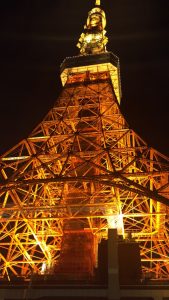
Upon arriving in Japan, I was extremely surprised by how clean and organized the entire city of Tokyo was. I had heard that Tokyo was a very tidy place because people do not dispose of their trash in public places, but it was shocking nonetheless. Compared to New York City, where I have lived for the past year, Tokyo seemed much larger but surprisingly easy to navigate with the extremely efficient subway system. I hate waiting at the subway station for upwards of half an hour when there are delays in NYC, but so far, this hasn’t happened in Tokyo.
As expected, the food in Tokyo is amazing. On the Sunday when we arrived, the entire Nakatani group ate ramen in Azabu Juban, near the hotel that we were staying in. The next morning, I tried the udon breakfast from the Sanuki Club, which was also delicious! For lunch, I stopped by a bakery in Azabu Juban and ate a savory pastry and Hokkaido milk bread (it was gigantic so I split it with Aaron, another Nakatani fellow). Some other noteworthy foods I have consumed include Teppanyaki in Azabu Juban, a glazed banana pastry from the same bakery as before, Korean bulgolgi beef from a food truck, and a green tea parfait from Nana’s Green Tea café by the Skytree.
One thing I found surprising about Japan was the fashion. Most Japanese women in the Minato area seem to dress quite modestly, always covering their shoulders and wearing pants or knee-length skirts. People here are extremely fashionable, and I wish I could pull off clothing like this in the United States. I visited Shinjuku and Tokyo Midtown to shop, and I was amazed by how gigantic the shopping malls were (and by how expensive the clothing was!).
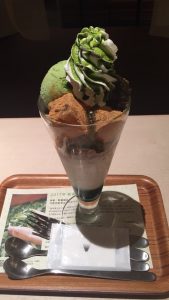
I was extremely nervous for the first day of language class because I had zero experience with Japanese, aside from memorizing the Hiragana and Katakana alphabets. I found the first class to be quite challenging, but I definitely learned a lot of useful phrases to use around Japan. I realized during the second class that I had accidentally bought the Kana version of the Japanese for Busy People textbook, instead of the Romanized version, which was why I had so much difficulty during the first class. Thankfully, I was able to share the Romanized textbook with another student in my language class. Throughout the week, I learned a lot about numbers, time, days of the week, months of the year, and grammar. I also learned how to introduce myself in Japanese, and say my name, school, major, and hobbies. I was able to practice Japanese out in the city over the weekend, which was terrifying, but I somehow got by (which a lot of English mixed in with Japanese)! I think the best strategy to learn Japanese is to try to use it out in Japan, and I’ve been taking my Japanese notebook with me when I go places in case I forget a certain word or phrase.
During the week, we had a Japanese culture seminar with Mr. Gibbs, who is a teacher at a senior high school. I learned a lot about the Japanese education system, which I really enjoyed. I was surprised to learn that extracurricular activities are encouraged in Japan and that people often practice sports for hours every single day. This seems really different from China, where most students focus all of their time and energy on either studying or sports (by training for the competitions such as the Olympics). Mr. Shikata’s talk about Japan-China relations and Japan-North Korea relations was extremely fascinating. I learned a lot about the TPP trade agreement, and it really piqued my curiosity in foreign affairs. I hope to learn more about foreign relations in the future.
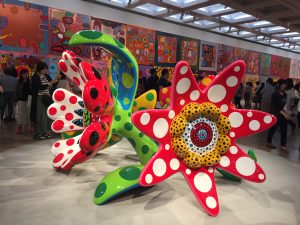
Question of the Week
Why do shops and restaurants close so early when Japanese people apparently have long working hours?.
Overview of Orientation Activities
The pre-departure orientation at Rice University was a great time to bond with the other Nakatani fellows and learn more about expectations for Japan. On Wednesday, after the majority of us arrived at the hotel, we ate tacos at Torchy’s and got to know each other a bit. On Thursday, we went through a few icebreakers with all of the fellows and shared what we were most excited to experience in Japan. We then received a general laboratory safety training and training for laser use. I had to take my last final examination while others were in an Introduction to Japanese Language and Culture seminar. We then had a BBQ with many people involved with the Nakatani RIES program, and were able to talk to several participants of NanoJapan in previous years, which was extremely helpful and comforting. Everyone really enjoyed their past experiences with the program, which made me extremely excited for the summer. On Friday, Sarah gave a talk on Health and Safety in Japan, which I found to be extremely helpful. Several of the fellows went to Target afterwards and bought some last minute supplies for Japan. Overall, I really enjoyed spending time with the other participants of the program and I found the talk on Health and Safety especially useful in helping me mentally prepare for the trip.
During week one of orientation, we had several seminars and group activities after language class, which was every day from 8:30 AM to noon. On Monday, Ogawa-san gave a lecture about the Nakatani Foundation and led us on a tour to the nearest JR station, where we all purchased a Suica card to use on the subway. We also walked about Azabu Juban, the neighborhood that we were staying in. On Tuesday, we visited the University of Tokyo and were given tours of several high-tech laboratories. We also had a discussion with several students from University of Tokyo, and they were all really nice! I actually became friends with one of them on Facebook, and I’m hoping we’ll keep in touch throughout the summer. On Wednesday, we visited the Edo-Tokyo museum and learned a lot about Japanese history. Afterwards, we attended a Sumo Tournament. The next day, we listened to a seminar from Mr. Gibbs, a teacher at the Super Science High School in Japan. He gave us a lot of helpful tips to living in Japan and taught us about cultural differences between Japan and the United States. Later during the day, we had a discussion about Japan foreign affairs with Shikata-san, who worked at the Japan Ministry of Foreign Affairs. On Friday, we attended Professor Nishikawa’s seminar about Science and Engineering in Japan, and learned a lot about Biology and its applications for the future. Overall, I thought that week one of orientation was a great introduction to Japanese culture and science in Japan. I particularly enjoyed the discussion about foreign affairs and the Sumo Tournament. Both were extremely informative and interesting to learn about. It was a busy week, but I learned so much!
Research Project Overview
My research topic over the summer will be related to the quantum sensing project using diamond at Itoh-sensei’s laboratory at Keio University. The overarching goal is to determine measurements that can’t be taken by conventional procedures by utilizing the laws of quantum mechanics. Itoh’s laboratory is currently investigating single nuclear spin magnetic resonance sensing using diamond, through which a single electron is placed in diamond and used to measure the magnetic field from nearby objects. A single carbon atom in the diamond is replaced with a nitrogen atom, which causes a nitrogen vacancy center (NV center). This NV center is a defect that will attract a single electron and creates a magnet. When a proton is placed above the NV center on the surface of the diamond, the magnetic field from the single electron nuclear spin can be measured. An applied external magnetic field will then create proton nuclear magnetic resonance. Electromagnetic radiation will freely change the direction of the proton nuclear spin and allow for nuclear magnetic resonance (NMR) detection of single proton nuclear spin. NMR is widely used in physics, chemistry, and the medical field for structural determination of new molecules and identification of extracted chemicals. Currently, NMR requires at least 1018 molecules of the same substance for measurement, but the Itoh laboratory’s research has potential applications in measuring NMR of a single molecule.
Paper Summary
High density nitrogen-vacancy sensing surface created via He+ ion implantation of 12C diamond
The purpose of this experiment was isotope purified diamond growth, nitrogen doping, and helium ion implantation in order to create a high density of nitrogen-vacancy (NV) centers in diamond for magnetic sensing. A high density of NV centers is desirable because it allows for higher magnetic sensitivity. A key challenge was to create this high density, while preserving desirable spin properties of the NV centers.
The methods include incorporating nitrogen in situ during diamond growth via chemical vapor deposition on an electronic grade substrate. In situ doping enables uniform nitrogen incorporation in the sensor and doesn’t disrupt the carbon lattice structure. To create vacancies in the lattice structure, the nitrogen-doped substrate was then implanted with He+ ions in an array. The sample was annealed so that NV centers would form from the doped nitrogen, and the sample was annealed again to convert the centers to a negative charge state because only the negatively charged state of the NV can be used for magnetic sensing. The negative charge state of the NV centers (NV–) was characterized and compared to single NV centers in a controlled sample, and it was confirmed that the centers were in the desired negative charge state.
The result of the research is a method for creating an ensemble of high-density NV centers with narrow spin-resonances, which reduce power requirements for magnetic sensing. The 100nm-thick sensing surface has a 1017 cm-3 nitrogen-vacancy density, which is 10 times less than the highest NV densities reported in previous research. However, the observed 200 kHz linewidth is over 10 times narrower. Future work can be conducted to optimize initial nitrogen density in the doping process, which could further decrease the optically detected magnetic resonance linewidth. The uniformity of the nitrogen incorporation during the diamond growth must also be investigated in order to ensure a false magnetic signal, as deviations in nitrogen incorporation densities will result in spatial variations over time and false magnetic signals.
Week 02: Language Learning and Trip to Mt. Fuji Lakes
Language class has been extremely challenging but rewarding. I love all three of the teachers that we have; they are so helpful, funny, and supportive. However, we learn so much every single day and I find it difficult to remember or retain the vocabulary and grammar that I learn. The most successful experiences I have had with Japanese language include being able to order at restaurants and ask for more water or for the check. The most frustrating aspect is that I often remember learning something in class, but I can’t remember the specific word or phrase for what I want to say. This happened during a conversation I had with a teacher from AJALT at the AJALT office. My mind completely blanked and I forgot how to say even the most basic sentences, and could not remember a lot of the grammatical sentence structure that I remembered learning. Luckily, the teacher that I spoke to was very kind and understanding, and reminded me of a number of phrases that I had previously learned in class. I was able to remember how to ask him to come with me to the ice cream shop (probably because I am obsessed with ice cream). My language goals are to study more vocabulary and grammar with Japanese students in my dormitory, and review everything that I have learned in class so far. I intend on creating a Quizlet for the vocabulary that I have learned so that I can review it every so often and ingrain the words into my long-term memory.
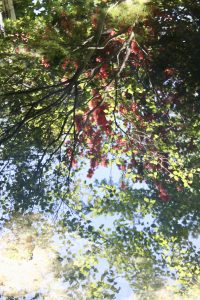
Over the weekend, the Nakatani US and Japanese fellows went on a trip to the Mt. Fuji Lakes area. We left from the Sanuki Club on Saturday morning in a bus and arrived at Mt. Fuji lakes in the afternoon. The lakes were beautiful, and I really enjoyed learning about the history and meaning behind each lake. Surrounding flowers also reflected off of the lakes, which created dazzling designs in the water. We also toured a temple by Mt. Fuji and learned about its significance. After visiting the temple, the Japanese fellows from Nagoya joined the rest of the US and Japanese fellows for a delicious lunch. We all introduced ourselves and were able to get to chat with each other at the lunch tables.
After lunch, we drove up the 5th Station of Mt. Fuji on the bus and stopped at the 5th Station to take pictures and explore the souvenir shops. The view of Mt. Fuji was absolutely surreal. It looked like it was out of a magazine! Several of the US and Japanese fellows and I asked one of the other Mt. Fuji visitors to take a picture of us. We asked Tomoyuki-san to ask someone to take a picture of us because he was obviously the most fluent in Japanese, but he actually asked someone in English! It turns out the people that he asked also spoke Chinese.
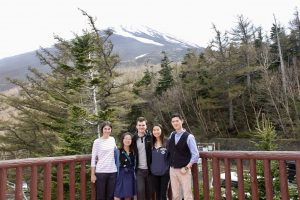
We then checked in at the hotel that we were staying at and ate dinner at a buffet nearby. Later that night, I went to the onsen with Savannah, Katelyn, and Shivani. It was so relaxing, and the hot water felt especially nice with the light breeze from outside. The next morning, we had a buffet dinner and then visited the Numazu Deep Sea Aquarium. Will discovered his deep sea spirit animal, the flapjack octopus. We then ate grilled seafood for lunch. We were each given plates of raw fish and shellfish, and barbecued everything on a grill in front of us. It was super fun and the most delicious meal I’ve had so far in Japan. We then drove to the Mishima Sky Bridge and walked across the suspension bridge. We were able to view a never-ending forest of trees. It was such a spectacular view, and especially refreshing because I don’t have the chance to see many trees in Tokyo or back home in New York City. After the trip to the Sky Bridge, we went strawberry picking. Strawberry picking in Japan is quite different from strawberry picking in the United States. In the US, we usually pick strawberries from an outdoor field and place them in a basket. We then pay for them by the pound or by the container and take them back home to wash and eat. In Japan, the strawberries are inside of a greenhouse, so they are clean and ready to eat. We picked them off the stem, dipped them in condensed milk, and ate them on the spot. It was so yummy!
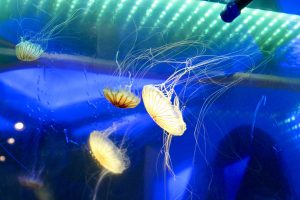
I had so much fun during the Mt. Fuji Lakes trip, especially because I had the chance of meeting and interacting with the 2017 Nakatani RIES Japanese Fellows. I learned that there are many cultural differences between Japan and the US. For instance, I learned that friendly contact (such as hugs) between males can make others uncomfortable, while the same contact between females is perfectly acceptable. However, there are many more similarities that bring us together. We are all so passionate about our studies and our research, and I really enjoyed talking to the Japanese fellows about their academic and non-academic interests. I can’t wait to see them again during the mid-program meeting!
In addition to the Mt. Fuji Lakes weekend trip, the US fellows also attended many cultural outings and seminars. On Monday, we visited Chinatown in Yokohama and ate delicious food. I particularly enjoyed the Taiko drumming on Wednesday and the IMAGINE ONE WORLD KIMONO PROJECT talk on Friday. We practiced for over an hour and learned how to play a song on the Taiko drums. It was tiring and my hands were a bit sore afterwards, but it was really fun! I enjoyed the KIMONO talk because I loved learning about fashion and the cultural significance behind the kimono.
Question of the Week: What are the most iconic regional foods of Japan?
There are so many! Check out the Regional Foods & Specialties of Japan section of our Food in Japan resources page. Also, when taking weekend trips in Japan, remember to ask your lab mates for suggestions of what you should eat or what treats/foods are specialities of the city or region you are traveling too. They’ll likely have great tips and this can give you insight into what type of omiyage the lab might most appreciate if you brought back to share with them.
Introduction to Science & Engineering Seminars
Itoh-sensei, my host professor at Keio University, gave a guest lecture during the Introduction to Science and Engineering seminar on Tuesday, after Professor Kono lectured about Quantum Mechanics. I learned more about the Itoh laboratory’s projects in quantum computing, and how Intel has recently invested a lot of resources into developing a quantum computer. The quantum computing process can essentially be divided into three components – initialization, operation, and read-out. Initialization orients all the qubits (quantum bits) in the same direction, operation runs programs to rotate the qubits, and read-out provides the output direction, up or down. Quantum computing has become more feasible as it has become possible to store quantum information for 1 second in order to implement error correction.
Professor Itoh also briefly talked about quantum sensing, which is the project that I will be researching on over the summer. This project will grow diamond composed of 100% 12C and put nitrogen-vacancy (NV) centers into the diamond. The NV center is extremely sensitive to changes in the magnetic field, and spin speed can be used to measure the magnetic field at a higher precision than any instruments that currently exist.
I considered the questions that Kono introduced during his first lecture. The material that is used to research quantum sensing is diamond with a nitrogen-vacancy (N-V) center. Standalone diamond is an electric insulator but an excellent thermal conductor. Diamond has 3D characteristic dimensionality. A unique characteristic of diamond is that it is the hardest known naturally occurring material. Diamond with crystal defects have a variety of applications because of their unique optical properties. For instance, NV centers can detect and measure magnetic and electric fields based on quantum mechanical reactions with the spin state of the NV center. Singular NV centers can be implemented for nanoscale sensing. A desirable property of NV centers is that they can operate at room temperature.
In addition to the Tuesday seminar, we visited JAMSTEC on Monday in Yokohama and learned about supercomputers. On Thursday, Professor Kono talked more about quantum mechanics and Kawata-sensei from Osaka University gave an interesting lecture about the research in his laboratory. Overall, I really enjoyed all of the science and engineering seminars from week two.
Week 03: Noticing Similarities, Noticing Differences
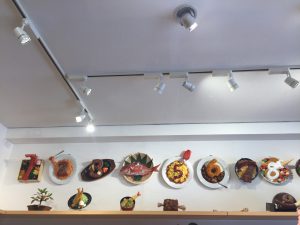
All the people riding public transportation in Tokyo seem to follow a set of unspoken but understood rules in order to ensure order (or perhaps the rules are listed in the subway station but I just can’t understand them). People always sit in such a manner that will take up the least space possible. They will put any bags that they are carrying in their lab or in front of their feet if the subway is not too crowded. Standing commuters will face the seated people, which I find quite interesting. In New York City, it would seem awkward to stand facing another person you do not know, but perhaps people in Japan do so because having their backside facing someone may be rude. When the subways are busier, such as during rush hour in the morning or the evening, people will do their best to conserve space. When trains are relatively empty, people seem to sit spaced out so they are a comfortable distance from others on the train.
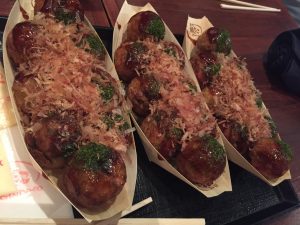
Typically, people are using their phones or listening to music. I don’t often see people having conversations with others on the subway, or if they do, they do so very quietly so they do not disturb others on the train. They also do not eat or drink on the subway cars. When compared to New York public transportation, people in Tokyo seem much more polite and respectful of others.
Commuters are also extremely kind and willing to help others. For instance, today I was taking the Namboku line from the Sanuki Club to Hiyoshi Station so that I could check in to my dormitory. I was carrying two suitcases, one approximately 50 pounds and the other less than twenty. While I was taking the escalator into the station, another commuter saw me struggle to get both suitcases onto the escalator, and she took my lighter bag and helped me carry it down to the station. Even after I tried to refuse her help, she continued to carry my bag and even directed me towards an elevator after I swiped into the station. I am extremely appreciative of her help, and these acts of kindness inspire me to be more helpful towards strangers in my everyday life.
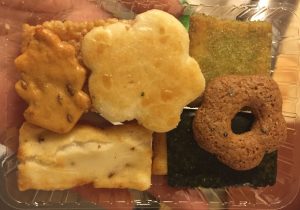
The transit system itself seems to be more efficient in Tokyo than in New York, for the most part. Trains generally arrive exactly on time and follow the schedule, whereas there are always delays on the New York Metro. I have also never seen a door come close to closing on a person in Tokyo. In New York, I often hear “please stand clear of the closing doors” as people almost get cut in half by the merciless subway doors. My only complaint is that the Tokyo Subway system does not operate 24 hours. However, this has not really affected me in any way (but it did make me more hesitant to visit the Tsukiji fish market at the crack of dawn).
In general, Japanese culture tends to emphasize respect towards others and towards the environment. The emphasize on harmony (“wa”) is extremely evident when examining subway protocol, where I often notice that members will put the peace of the entire subway car above their own interests (such as talking loudly or eating). This is not really the case with foreigners who ride the subway, but I think people do tend to notice when actions are inappropriate or unacceptable and try to avoid doing them.
Question of the Week
Where did the clear plastic umbrellas originate from and why are they so popular? Is there a quality difference between an umbrella from a hyaku yen shop vs a more expensive clear plastic umbrella?
- It is quite simply very convenient and inexpensive to be able to quickly buy a clear, plastic umbrella at any convenience store, kiosk, or 100 Yen shop when you most need it. Just like vending machines, on rainy days there is almost always a clear umbrella you can buy very nearby.
- Also, since you must often leave your umbrella outside of the buildings (and not all buildings have umbrella locks or they are sometimes full) it is easiest if all the clear, plastic umbrellas are essentially the same. That way you just dump yours in the bin and when you leave fish out the most convenient one to grab. Since they are all almost alike there is no way you could find ‘yours’ in the bin most times and the fact that they all cost about the same amount means the one you grab will likely be a similar design and cost to the umbrella you left in the bin. Of course, if you can find ‘your’ clear umbrella its best to take that one, but if you stand and try to figure out which one is yours long enough someone else will probably come by and just grab the closest one and go without any worry.
- The History of Clear Plastic Umbrellas in Japan (Iromegane)
- Enjoy Rainy Days with a Japanese Umbrella (Japan Monthly)
Introduction to Science & Engineering Seminar Overview
This week, Professor Stanton of the University of Florida facilitated two Introduction to Science and Engineering Seminars, and we also listened to two guest speakers. I particularly enjoyed Dr. Futaba’s talk on Carbon Nanotubes, and I found his cultural tips for living in Japan as an American to be entertaining and helpful.
Over the summer, I am studying nitrogen-vacancy (NV) centers in diamond, which contain ground and excited states that are spin triplet and can be split into 3 spin sublevels. NV centers can be excited between the ground and excited states with wavelengths in the range of 530-640. There is an additional metastable single state with a much longer lifetime than the excited state (250 ns vs 25 ns).
NV centers absorb green light and emit broadband photoluminescence signals of different wavelengths for neutral and negatively charged NV states. NV defects in diamond can thus be easily detected using optical confocal microscopy. The photoluminescence of the NV centers is also perfectly photostable at room temperatures, whereas other solid-state emitters such as quantum dots are not. This is utilized in the field of biology, where NV centers are used as fluorescent labels. The spin state of the NV center is coupled to the luminescence, allowing for the detection of the local magnetic field through measurements of the luminescence.
My project is to design an antenna that will utilize the angular momentum of a rotating magnetic field and ultimately change the quantum states of the NV center from ms = -1 to ms = 1. I am currently reading papers related to microwave engineering and technology, but I am still a bit confused about the overall purpose of this microwave antenna and what exact role in plays in the process. I plan on continuing to read papers and consulting my mentor but it would be helpful to learn more about magnetism and optics, as I don’t think my introductory physics class has prepared me very well for this research.
Return to Top
Week 04: First Week at Research Lab
I took the subway from Azabu Juban station to Hiyoshi station on Monday and met up with Shogo, a bachelor’s student in my laboratory. Shogo helped me check in at my dormitory (even though we got a little lost on the way there). Afterwards, we walked to the laboratory, which was on Yagami campus, and I was introduced to several members of the lab. At 11:30, the laboratory had a welcome lunch for me, with Japanese-style pizza. Afterwards, Kento, my main mentor, showed me around the basement labs and explained the laser setups. At 3:30, I had a meeting with Professor Itoh, Kento, and Professor Monnai from a neighboring lab. We discussed my project and how I would be collaborating with the Monnai Lab and the Itoh Lab.
Kento is extremely smart and knowledgeable about his field. I read a few papers on my second day, and had some questions, so I asked Kento. He explained the very basic concepts in a very understandable manner, and it was extremely helpful. However, Kento is fairly busy, and it’s been a bit difficult to find a time for another meeting between me, Kento, Professor Abe (another mentor), and Professor Monnai.
Everyone in my lab seems to speak English well and can understand me, especially if I speak slowly. However, most casual conversations are in Japanese, and it’s a bit difficult for me to participate. I attended my first group meeting today, which was entirely in Japanese, aside from the PowerPoint slides. A bachelor’s student was presenting his research, and bachelor’s students are allowed to present in Japanese. However, master’s students must present in English, so future group meetings should be more understandable. My limited Japanese knowledge should not impede the actual research that I’m doing, but it is difficult to become friends with my lab mates. There is only one other international person in my lab, and he doesn’t seem to socialize much with the rest of the lab either.
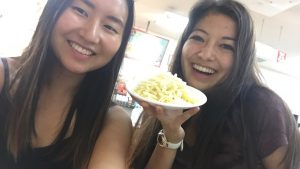
I am staying in the Hiyoshi International Dorm, which is a fifteen-minute walk from the laboratory. The dormitory was just built in this past March, and is designed to foster interaction between Japanese students and international students. There are units of 4 students, 2 Japanese and 2 international. The units contain a shared bathroom, couch, and TV. There is also a shared kitchen on every single floor. While the individual rooms are a bit small, it’s not much different from my dormitory in NYC, and everything is so much newer.
The people in my dormitory are also really friendly, and I’ve made some good friends already. I met Michiko in the kitchen when I was cooking pasta, and she introduced me to Jenny,
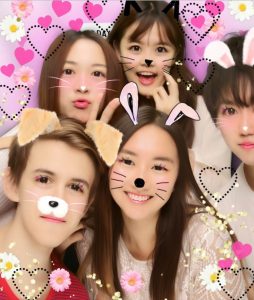
Elena, Meng Si, and a few other people on my floor. Elena is on the same campus as I am, so we ate taco rice together on Friday for lunch. Elena is from Germany, and has a lot of German friends. I met three of them during lunch, and was added to their group chat on Line. On Saturday, I went to the Vietnam Festival in Harajuku with Michiko and met some of her other friends from an international program with Keio University. We spent the whole day together in Harajuku and Shibuya, and had a lot of fun! At night, I met up with Elena, Jenny, and a few of the German guys, chatted, and ate some ice cream. On Sunday, Jenny helped me do my laundry, and I later went to the supermarket with Jenny and Elena. I cooked dinner with Elena, Jenny, and one of Jenny’s friends on another floor. We cooked curry chicken and rice, and it was delicious! I was initially pretty worried about making friends in my lab and in my dorm, especially when I first moved in on Monday. Everyone seemed nice, but I didn’t really feel included until I met Michiko. Now, I’m extremely happy with all the friendships that I have formed. I really hope I can keep in close contact with everyone, even after I leave Japan.
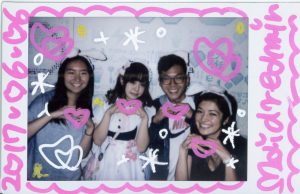
Reflection on Three Week Orientation Program in Tokyo
Overall, I really enjoyed the orientation program. We were often very busy, with language class and seminars, but I loved spending time with the other Nakatani Fellows and exploring Tokyo. After three weeks, I was looking forwards to settling down at my research laboratory, and meeting people in my dormitory and in my lab. I think the program really helped introduce some basic Japanese phrases that have helped immensely while getting around. I’ve also learned a lot about my travel habits and preferences during the orientation. For instance, I prefer to explore places either alone or with up to one or two other people. Especially in Japan, small groups are much quieter than large groups, and I try not to be disruptive to others, so the smaller groups work very well.
Question of the Week
How are experiences in Japan different for foreigners who look obviously foreign vs. those who are from other Asian countries that tend to blend in with Japanese people?
- Please see the section on Being a Foreigner in Japan on our Life in Japan resources page. Some of the articles listed on here may give you some insights on your question.
Research Project Update
The goal of my project is to design a microwave antenna that will excite electrons from a nitrogen vacancy center in diamond from the -1 spin state to the +1 spin state. The antenna should apply a rotating magnetic field to the diamond sample, with the field always oriented in the same direction at every point. If this project is successful, the results would allow for more control of the spin states in NV centers. Previously, electrons have only been excited from ms = 0 to ms = -1, or ms = 0 to ms = +1 using circular polarization, but never from ms = -1 to ms = +1.
I will be designing an antenna on the CST Studio Suite, which is an electromagnetic field simulation software. The CST Microwave Studio simulates high frequency devices in three dimensions and can be used to design and analyze microwave antennas. I will be working with the CST suite and hopefully have a design by the beginning of July. In early July, the design will be sent to another company to be created. We should receive the completed antenna within a week or two, and then we will perform preliminary tests on the antenna starting in the middle of July. If the preliminary tests show favorable results, more detailed tests will be performed until I have to leave the laboratory. During the few weeks that I am waiting for the antenna to arrive, I will be brainstorming ideas for improving the antenna and adding additional features, such as frequency tunability.
In the past week, I have received a bit of training with the CST software. Professor Monnai shared a guide with me that explained the basics of the program and I followed the tutorial to make a conducting pipe. I have also been learning more about nitrogen vacancy centers in general through reading papers, and I have read papers about the two antenna designs that were published in papers by the laboratory last year.
Week 05: Critical Incident Analysis – Life in Japan
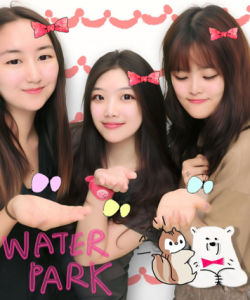
Two weeks ago, I took an early train from the Azabu Juban station to the Hiyoshi station. I dragged two overstuffed suitcases back and forth along the platform, looking for the exit. This was the day I was supposed to move in to my dormitory, and I was frantically searching for the person from my lab that volunteered to pick me up and help me check in. Looking back at it, Hiyoshi station is really not that complicated. There are three levels, with the top level being the exit, the middle level being the platforms for the majority of the subway lines, and the bottom level being other forms of underground transportation. However, that day, I was just completely and utterly lost.
I approached someone in a uniform who seemed to work at the station, hoping to be pointed in the correct direction. However, my mind blanked and I could not remember the Japanese word for ‘exit,’ so I was stuck improvising with a broken combination of English and Japanese. “Exit wa doko desu ka?” Unfortunately, the person that I approached did not understand what “Exit” meant, and had an extremely confused look on his face. I tried to explain that I did not speak Japanese very well. He called over another uniformed man and spoke rapidly in Japanese, and then directed me to an elevator. They both made several hand gestures and spoke more Japanese, as I nodded but did not really understand what they said. I rolled my massive suitcases into the cramped elevator and took the elevator in the only direction that it went, which was down. I quickly realized that the bottom level of the station was not where I wanted to be, and took the same elevator back up to the platform. The officer noticed me come back up the elevator, seemed even more confused, and tried to talk to me again in rapid Japanese.
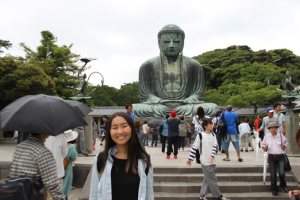
My phone started ringing with a notification from LINE – the student from my lab that was picking me up had arrived at the station. I picked up and told him that I was a bit lost, and sent him a picture of the platform that I was at, and he was able to find me very quickly. Embarrassed, I said “Arigato gozaimashita” to the officer and introduced myself to my lab mate, Shogo.
While this was only a minor miscommunication, I probably wasted 20 minutes walking around the station and going up and down the elevator. I’ve now learned that the word for exit is “Deguchi” and that the proper phrase would be “Deguchi wa doko desu ka?” which is good to know for future reference, although I may not understand the response in Japanese.
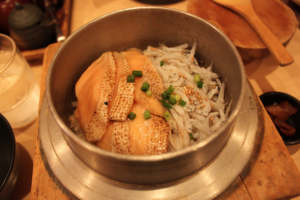
Aside from minor miscommunications, I don’t think I have had any major incidents or disasters in Japan yet, and hopefully it will stay that way. I have, however, had a lot of fun adventures! On Saturday, I went to a water park in Yokohama with Michiko and met Michiko’s friend, Mew. Later that night, I ate delicious ramen in Hiyoshi with Michiko and Mike, who is one of my friends from the US. Mike is studying Japanese over the summer at a language program in Shinjuku. On Sunday, I went to Kamakura with Michiko, Jenny, Elena, and Josh (from the Nakatani program), and saw the Daibutsu at the Kōtoku-in temple. It started pouring, so we sat in a café and just talked for a few hours, which was nice. For dinner, we ate a delicious seafood meal in Kamakura!
Question of the Week
What are the ideals of beauty in Japan and how do they compare to those in the United States?
- Beauty is in the Language of the Beholder (Tofugu)
- Ono no Komachi and the Standard of Female Beauty (Tofugu)
- Why Japan Historically Hates Mustaches (Tofugu)
- Articles on Japanese Fashion (Japan Times)
- Japanese Women and Fashion (Huff Post)
- Japan: 100 Years of Beauty (Video)
- The Fair Face of Japanese Beauty (Nippon.com)
Research Project Update
I’ve spent my week continuing my project as planned. I had a meeting with Professor Monnai, Professor Abe, and Kento on Tuesday and we discussed specific design requirements for the antenna. The antenna will have 8 copper loops arranged in a circular shape, and it will emit microwaves and generate a magnetic field, with a Pi/2 delay between each loop. I began designing the antenna on the CST software on Wednesday, and continued for the rest of the week. Initial designs are finished but I need to run simulations and alter parameters to maximize the magnetic field that is generated and ensure that the generated field behaves as expected. I have been talking with Kento a lot and he believes that the antenna design will be successful. I also need to consider whether there are more efficient designs. It is sometimes a bit difficult to use the CST software because there are also other people in Professor Monnai’s laboratory who need to use it, so I can reserve up to 4 hours of time with the computer per day.
Next week, I intend on talking with Professor Monnai and Kento again about the simulation results, and continue making alterations to the antenna design. I also need to figure out a way to couple this antenna with another antenna that will excite electrons from ms = 0 to ms = -1, so I will work on that after altering the current antenna design.
Week 06: Preparation for Mid-Program Meeting
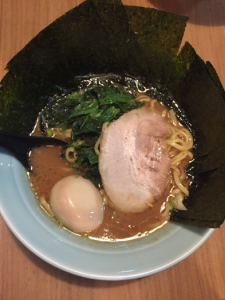
Last Monday, my mentor randomly asked me if I liked ramen, and then invited me to join several other lab members at dinner. I was pleasantly surprised because while I have been friendly with all of the Japanese people in my lab, my relationship to them was closer to that of a co-worker, rather than a friend. We went to a ramen restaurant in Hiyoshi, my lab mates translated the menu for me, and gave me recommendations for what to order. The food was delicious, and I had a lot of fun talking to my lab mates and laughing at their jokes. We have this running joke now about Okinawa because I mentioned that I wanted to go but couldn’t drive so it would be difficult to get around the island. However, this was misinterpreted as “I don’t have a license so I can’t drive to Okinawa,” and they thought I was trying to drive across the water. Throughout the week, my mentor and I have been talking about more casual, non-research related things, and I am becoming closer with my other lab mates, as well. On Wednesday night, I went to a yakiniku tabehoudai with the majority of my lab, Itoh-sensei, and Itoh-sensei’s lovely wife. While there are occasional miscommunications and language barriers, I am really happy to get to know the members of my lab.

I think my biggest personal accomplishment thus far has been meeting so many people and making friends from all around the world. In addition to my Japanese lab mates, I have become friends with people from Thailand, France, Italy, Germany, Korea, Taiwan… and the list continues to grow. I have learned so much about different cultures, more than I could have ever imagined.
The best part about having friends from different groups (my lab mates, students my dormitory, friends from Nakatani program, friends from back home who are visiting Japan) is that I am able to join in on diverse experiences and adventures. I enjoyed authentic ramen from a small ramen shop with my lab mates, a place I never would have discovered on my own. I attended a Keio basketball game with friends in my dorm. I explored Shibuya at night with a German friend who also works on my campus. I am so excited for all of the exciting adventures to come, and I know I have an amazing network of friends to explore Japan with.
My biggest challenge was yesterday, about two hours after getting lunch in the Keio University Yagami Campus cafeteria with several of my lab mates. There was a special dish this week, containing rice, yamaimo (mountain yam), seaweed, and tuna. I normally don’t particularly enjoy eating tuna, but I decided to try it because it was so well-advertised in the cafeteria (with posters of this dish everywhere). The dish was interesting, not exactly unpleasant, but quite slimy because of the yamaimo. I felt fine after consuming it, and continued on with my research in the laboratory. I began to feel a bit nauseous a few hours later, in the middle of talking to my mentor about the simulation that I was currently
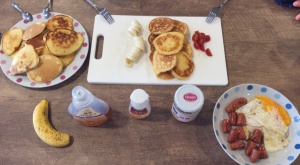
running. I realized that I had food poisoning, most likely from the meal in the cafeteria, and I spent the next hour in the bathroom, sitting on the ground in a cramped bathroom stall with a toilet conveniently at my side. Needless to say, this has been my most uncomfortable experience in Japan. Around 2:30 pm, I decided to leave the laboratory and return to my dorm to get some rest. I spent the next few hours lying in my bed in fetal position, trying not to think about slimy mountain yams and vowing to never eat tuna ever again. These things happen, but I’m a bit hesitant to return to the Keio cafeteria from now on.
Question of the Week: Why is the Shinkansen so expensive? Even more than plane tickets sometimes?
- There is a lot of infrastructure and staffing that go into building and maintaining the Shinkansen lines and you are also paying for convenience. While the initial cost of the ticket might be cheaper to fly, you still have to pay to get to the airport, if you are traveling with large suitcases you might need to pay to send your bags to the airport via Takuhaibin so you don’t have to lug them on the subway, and you also lose out on additional time since you have to get to the airport early to check-in and then wait at the baggage carousel and then spend another hour travel time (usually) to get from the airport back to the center of town.
- When traveling via Shinkansen, trains typically depart and arrive at fairly central stations, there is easy luggage storage right on the train, the seats are very comfortable, and you can rest/relax or work if you need to. You are paying extra for the convenience and the comfort of the Shinkansen and when you add in all the additional costs with flying then the cheap discount airfares might not be as huge a cost-savings as you might think at first.
- But yes, there are plenty of very cheap flight options in Japan and it is sometimes surprising for foreigners that it can be cheaper to fly than tot travel by train in Japan. There are even special discount air passes that are similar to the discounted JR Rail Pass that is open to foreigners in Japan.
Research Project Update
I designed a preliminary model of the antenna on the CST software and ran simulations on Monday, which took a few hours. The simulations run fairly slowly, so there is a bit of downtime while I wait for results. The magnetic field generated was a different phase than expected, but my mentor and I quickly realized that the phase switched for one half of the antenna, so we were able to “fix” this problem. On Wednesday, Kento and I met with Professor Monnai to discuss the results of the first iteration simulation. We decided that we would need to scale the antenna up to a more feasible size, a size similar to the antenna created last year by a German masters student. We also discussed the line impedance of the copper loops and how it needed to match the SMA connector for connecting the coaxial wire to the antenna sides. The current impedance was around 200 ohms, but it needed to be around 50 ohms (impedance of SMA connector). To fix this, we are attempting to add a layer of copper to the back of the substrate to act as a capacitor with the copper lines. We also want to know the relationship between the width of the copper lines and the span between the two copper lines that make up the loop. We then discussed the shape of the antenna, and Professor Monnai suggested that we vary the angle that the antenna loop sides made with each other to reduce the sharp edges so that current can flow better through the loop. At the end of the meeting, Professor Monnai asked me if I had experience with simulation software before. When I replied “no,” he said that I must be a natural at CAD and simulations.
For the rest of the week, I worked on implementing the changes that Professor Monnai, Kento, and I discussed. It was a bit difficult to schedule times to use the CST software because members of other labs have also reserved it, but I think I am making decent progress on the project. Hopefully, a finalized design can be created in the next week or so.
Return to Top
Week 07: Overview of Mid-Program Meeting & Research Host Lab Visit
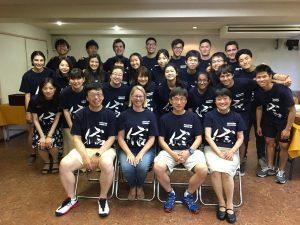
The Mid-Program Meeting was an amazing few days to reunite with the other Nakatani fellows. I had met up with several of the US Fellows throughout the first month of research, but did not see any of the Japanese Fellows until the Mid-Program Meeting. We walked around Kyoto, celebrated a few Nakatani birthdays, and returned to the Kyoto Traveler’s Inn and talked for hours. I’m quite sad that we will only be seeing the Japanese Fellows again at the last meeting in Tokyo before we head back to Houston.
On Sunday, all of the US fellows were gifted yukatas, and then the entire group of Nakatani US and Japanese fellows attended a tea ceremony. The yukatas were so beautiful, and I’m thankful for the opportunity to learn about Japanese traditions and culture. On Tuesday, we visited several temples and shrines in the city, along with an art museum and a manga museum. We went to the headquarters of Sysmex, the company behind the Nakatani Foundation, and learned about the company history on Wednesday.
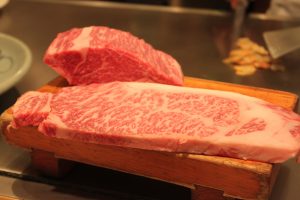
Katelyn and I stayed in Kobe for dinner on Wednesday night, and consumed quite possibly the most delicious meal we will ever have (at least, for me). We spent the bus ride to Sysmex researching restaurants that prepare A5 Kobe beef, which is one of Kobe’s specialties, and made a reservation for an early dinner. Upon getting there at 5, there was no one else in the restaurant, so we were able to peacefully enjoy our meal. The chef sliced and diced the beef on a grill in front of us, with awe-inspiring expertise. He also recommended different sauces and seasonings for our food. Kobe beef is quite pricy, but our mouth-watering food was well worth the money.
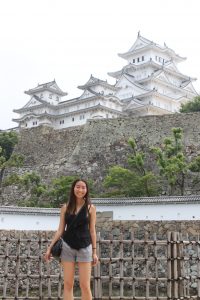
My mentors were in Hong Kong for the entire week so I had the opportunity to travel after the Mid-Program Meeting too. On Thursday, I left Osaka early in the morning and caught a bus, train, and Shinkansen to the city of Himeji, home of Himeji Castle. Himeji Castle is a beautiful white castle, and one of the first UNESCO world heritage sites in Japan. I spent the majority of my afternoon there, and then visited Ko-koen Garden in Himeji, which was adjacent to the castle. I also ate a delicious udon lunch! Afterwards, I hopped on another Shinkansen and made my way to Kurashiki, which happened to be Ogawa-san’s hometown. I originally wanted to visit the Ohara Museum in Kurashiki on Thursday, but it was closed when I got there. Instead, I walked around Kurashiki and visited several of the small shops in the area. Kurashiki is quite well known for their Bikan historical quarter, which contains many shops and restaurants with classical Japanese architecture. The entire historical quarter is a beautiful, with white storefronts and trees with wispy green branches.
I stayed in a hostel in the Bikan historical quarter on Thursday night, and woke up early morning on Friday to visit the Ohara Museum right when it opened. The Ohara Museum is the first Japanese museum dedicated to Western art. I spent my morning gazing at beautiful paintings by artists such as Monet, Pissarro, Picasso, and many others. I really love the Impressionism movement, so the Ohara Museum was a perfect place to visit. After spending a few hours in Kurashiki, I headed to Naoshima, a small island close to the Okayama prefecture that contains spectacular modern art exhibitions.
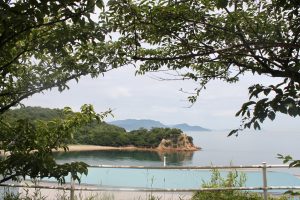
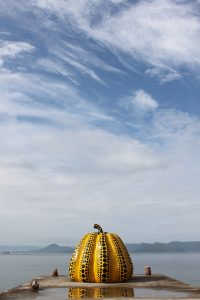
I spent the rest of Friday, and the majority of Saturday in Naoshima. It was one of the most relaxing and inspiring places that I have ever been to, perfect for some peaceful introspection. The art and architecture was absolutely stunning – I can’t even begin to describe it. I didn’t want to leave, but sadly had to catch another Shinkansen to Hiroshima and check into my hostel on Saturday night.
Before checking in, I met up with Katelyn and her parents, and ate Hiroshima-style okonomiyaki in Okonomimura, a building with several floors of restaurants dedicated to providing Hiroshima residents and tourists with delicious okonomiyaki. Katelyn’s parents were extremely nice, and I met up with Katelyn and her family again on Sunday morning. We visited the Hiroshima Peace Memorial Park and museum, and I learned a lot about the effects of the atomic bomb dropped in 1945. I made my way to the Hiroshima airport in the afternoon and flew back to Tokyo after four exhilarating days of traveling on my own. This was actually my first time traveling long distances by myself, and staying in hostels. I have always traveled with friends or family, but I realized that solo adventuring is extremely peaceful and relaxing, and I will definitely be doing it again in the future.
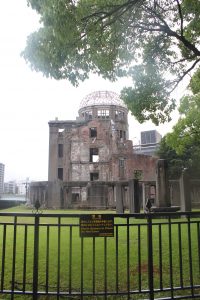
Question of the Week
How have Japan-US relations evolved since WWII?
- You might want to review some of the articles we’ve posted about WWII under the History in Japan section of our Life in Japan resources page.
Research Project Update
I spent the majority of my week before the Mid Program meeting preparing my presentation about my research updates, consulting my mentor about my PowerPoint slides, and running simulations for my project. A five-minute presentation is actually much harder than it looks, because you have to know all of the specific details of your project in case people ask you questions, but you don’t have enough time to thoroughly explain many of the scientific concepts behind it.
I spent a lot of my time learning more about Spin and Orbital Angular Momentum and how it affects my project. While one goal of the research is to excite electrons in an NV center from spin state -1 to +1, the broader question we are trying to investigate seems to be if we can transfer orbital angular momentum to spin angular momentum for a single spin, which can be modeled by the NV center system. I haven’t taken quantum mechanics yet, so my knowledge and understanding of spin and orbital angular momentum was quite limited, but I tried to learn as much as I could through reading papers and online resources.
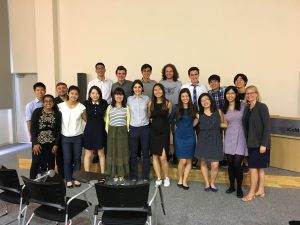
I had another meeting with Kento and Professor Monnai about the antenna simulation results, and implemented some final changes to the design. I then started running more simulations on Friday, but Kento said that the design looked very nice and should be almost ready for fabrication. Because he will be away the entire week of the Mid-Program Meeting, we will likely examine the simulation results and order the antenna during the week of June 10th.
Week 08: Research in Japan vs. Research in the U.S.
My lab environment is quite relaxed and friendly, which I really like. I get along well with my mentor, Kento, and we find amusing things to talk about aside from research. He likes to joke around a lot, especially with other lab mates and with the German friends that I often eat lunch with (Kento occasionally joins). We often have conversations about the differences between Japanese and US culture. For instance, Kiga, another PhD candidate in the laboratory, claimed that his favorite soft drink was root beer. Kento laughed at this and said that it’s very strange, and that he, along with the majority of Japanese people, dislikes the taste of root beer because it tastes similar to a Japanese medicine. We then spent the next 20 minutes looking up statistics about how popular root beer is in America compared to other soda brands (but we never really arrived at a definitive answer). I was a bit intimidated by Kento at first because everyone else in the lab really looks up to him, and he is incredibly smart and hardworking, but we soon developed a friendly relationship outside of solely research.
It seems like the lab environment is quite hierarchical for the Japanese members, but the other international researcher and I don’t seem to fall anywhere on this hierarchy because we are so “different.” Thus, while many of the bachelor’s students address Kento by Sasaki-san, he asks me to call him Kento or Ken instead of the more formal greeting. I can definitely sense that Kento acts as a mentor for the younger students, and highly respects the assistant professors and Professor Itoh.
My last research experience in the US was during the summer after my junior year of high school and throughout my senior year at the Wei You laboratory at the University of North Carolina at Chapel Hill. I was a bit younger then, and definitely less knowledgeable about the research process and the field that I was researching at the time (Chemistry). I notice that there were younger bachelor’s students at my lab at UNC than at the Itoh group, but also more postdoctoral researchers. I know that this is because most bachelor’s students in Japan do not have the opportunity to research until their B4 (senior) year, but I’m not sure if the postdoctoral researcher difference is a cultural difference or just a random occurrence. Because I was comparatively younger than everyone else in my lab at UNC, the other researchers were friendly towards me but did not engage in much conversation outside of research. This is different from the Itoh group lab environment. I feel a lot more included in the Itoh group environment, even though I am here for a shorter time than I was at the UNC lab. In fact, I am going to a lab trip to Yamanashi this upcoming weekend for peach-picking because this is Kento’s favorite fruit/dessert.
I also notice differences in work habits in the US laboratories vs in the Japanese laboratories. Most people in the Itoh group arrive around lunch time or slightly after they have eaten lunch, and stay a bit later, until 6 or 7. I think Kento is a bit of an anomaly because he seems to stay at the lab at all hours, and even occasionally sleeps on the couch of the student area. In the US, most people at my lab would arrive between 9 am and 11 am and stay until 4 or 5 pm, which is a bit earlier than in Japan. I think my current lab mates tend to work more longer hours than the people in my previous lab, who would all generally go home at the same time every day instead of staying later.
Sarah, Ogawa-san, and Professor Kono visited my laboratory this Monday. Professor Kono gave a talk about Carbon Nanotubes during my group seminar, and Sarah and Ogawa-san joined us shortly after Professor Kono’s presentation. Professor Itoh showed us the Dean’s office, as he is the dean of the Keio University Yagami Campus, and I showed my research results to Professor Monnai, Sarah, Ogawa-san, and Professor Kono. In this laboratory visit, I also learned that many US labs have inter-lab collaboration, while this is less common in Japan, especially for labs at the same university. However, my project is a collaboration between the Monnai laboratory and the Itoh laboratory, and I am quite thankful to be a part of this collaborative effort and learn about how collaboration works in Japan.
Research Project Update
On Monday, after my laboratory visit from Sarah, Professor Kono, and Ogawa-san, I discussed my simulation results from two weeks ago with Kento, Professor Monnai, and Professor Abe. They could not think of any distinctive improvements that I could make to the design, so we began investigating the parts that we would need to order for the setup. The order for the antenna was also placed. One thing that my design did not take into account was how to excite electrons from the NV center from the 0 state to the -1 state, so I discussed this with Kento, and I believe that Kento discussed this with Professor Abe on Tuesday morning during a progress update. On Tuesday, I worked on a slight addition to my current antenna design to integrate another antenna that should excite electrons first from 0 to -1 spin states. I then shared my simulation results with Kento and Professor Monnai, and I believe that two copies of this antenna have also been ordered.
Overall, I am slightly behind the original schedule that I developed during my first week of research. I was not able to finalize my design until now because my mentors were in Hong Kong for a conference and my simulations did not finish before they left. However, I still believe that there should be abundant time to implement testing on the antenna. For the rest of this week, I intend on working on my research abstract and poster, and making any additional adjustments to my antenna design as needed.
Question of the Week
The US seems to have many initiatives to encourage females to become more involved in STEM fields, which has decreased the difference in the gender ratio. However, this is still quite a large gender disparity in Japan in STEM fields. Does Japan have any initiatives similar to the ones in the US to encourage females to pursue STEM?
- Yes, there are some and you might want to review some of the resources we’ve listed on the Women in STEM in Japan section of our Doing Research page. There are also a number of non-profit organization and groups focused on promotion of diversity and equality within STEM fields in Japan such as:
- But, as you have seen through your own experience in Japan, women are still highly underrepresented in STEM in Japan, particularly in academia, so there is still a long way to go.
- You may also want to review the website profiles of the female 2017 Japanese Fellows as many of them talk about issues related to gender in STEM both in terms of their experience in Japan and what it was like to do research in the U.S.
Week 09: Reflections on Japanese Language Learning
The majority of my Japanese language learning was concentrated in the first three weeks of the program, when we had language class every single morning from 8:30 – 12:00. While I hate to admit it, I think my Japanese language ability has deteriorated a bit since then, instead of improved.
I spend the majority of my time either in my dormitory (or with my dormitory friends in Tokyo), and in the laboratory. Even though half of my dormitory consists of Japanese students, I find myself associating with many more international students. I think this is because the Japanese students are often studying, while many international students think Keio is much easier than their home university, and don’t necessarily need to get the top marks in order for their credits to transfer. Also, by nature, many of the international students seem to be more outgoing and welcoming than the Japanese students, and feel more comfortable with speaking English. While I would love to practice my Japanese with a Japanese student, it is often difficult to find time that works for both of us.
My laboratory is entirely Japanese, aside from me and a French researcher. I don’t see this French researcher very often, because I think he spends most of his time in another laboratory space. The majority of my conversations with the Japanese researchers are in English because they know I am more comfortable speaking it. They do, however, teach me casual Japanese phrases, likely the equivalent of English slang. When they speak to each other, they mostly speak in rapid Japanese and translate it for me in English. This was especially noticeable during a lab trip that we took this past weekend to Yamanashi and Hakone.
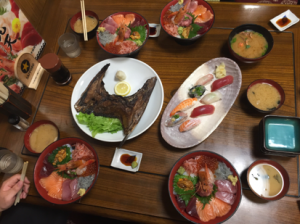
On Friday, Kento, Kiga, Keita and I met at Hiyoshi station and hopped into Kiga’s car. After sitting in a car for a few hours, we arrived at a peach picking orchard in Yamanashi. Peaches are Kento’s favorite dessert/fruit so he wanted to organize a lab-wide peach picking activity. Afterwards, we drove around Yamanashi, went to a park, and drove Mario Karts at a kart racetrack. This was my first time driving a Mario Kart, and it was quite exhilarating. I don’t normally drive in the United States because the boarding school I attended for high school did not allow cars, and I now attend college in NYC and just take the convenient public transportation. However, I really enjoyed racing around the track, even though I was much slower than the guys in my lab.
We then drove from Yamanashi to Hakone, and stopped for a seafood meal in between. I noticed during the car ride that Kento, Kiga, and Keita would speak in Japanese the entire time. I felt a little bit left out of the conversation, but I didn’t mind too much because I was asleep for most of the car ride. They would occasionally pause their conversation in Japanese and ask me a question in English, or explain something. I was also introduced to Japanese music, because we rotated the aux cord and Keita played some Japanese pop music. When it was my turn to play music, I noticed that Kento really liked The Beatles and acoustic music, so I tried to play more songs like that.

We ended the night in an onsen in the apartment we rented in Hakone. I went to a smaller onsen that fit 1-2 people, while they went to a slightly larger one for 3-4 people. The two baths were separated by a large rock wall, but I could hear over it. They seemed quite worried about me because I was in an onsen alone, and kept asking me every few minutes if I was okay.
The next day, we had breakfast near the apartment and then drove to Mt. Hakone, a volcano. We then met up with two other members of the lab, Matsuoka and Kuroda. The previous night, Keita and Kiga imitated Matsuoka, who often said “Hai” and “So desu ne” in a very deep voice, so it was very funny to hear Matsuoka say these phrases in person. I also learned that Hakone was very popular for their onsen tamagos, or eggs dipped in onsen water. The onsen water contains sulfur, which reacts with the calcium in the eggshell, and turns the eggshell black. However, I think the actual egg part tastes the same as a normal hard-boiled egg. Regardless, it was very delicious. We then visited the Hakone open-air museum, which had many nice outdoor sculptures. There was also an indoor Picasso exhibition with several hundred of paintings and sculptures. I really enjoyed visiting this art museum, and it was very interesting to see sculptures by both Japanese and Western artists. We then began driving back to Hiyoshi, which was another 2-3 hour car ride.

I don’t think there has been a specific incident where I felt very challenged due to my limited Japanese ability, but I think it has been overall a bit difficult to communicate with my lab members in a group when they are all speaking in Japanese. I also feel bad for making them constantly translate things for me into English. I think I have learned quite a few Japanese words and phrases from them, but I am still not comfortable engaging in a conversation in Japanese.
I think Japanese language is beautiful, and I wish I had more time to commit to learning it. However, from my previous experiences with learning languages, I know that I am quite bad at remembering vocabulary, and that I forget grammar very easily when I do not use it every day. I would love to learn more Japanese one day, but I don’t think it’s feasible to take Japanese classes at my home university because I have so many engineering-related classes that I am required to take. Being in Japan, however, has renewed my interest in learning more Chinese because of the Kanji characters in Japanese language. I attended Chinese school for many years, until 6th grade. I am fairly fluent in speaking and listening to Chinese, but I have forgotten how to read and write over time. After being surrounded by Kanji in Japan, I was really sad that I could not remember what many of the characters meant, so I hope to re-learn some Chinese by studying my old textbooks.
Research Project Update
Most of my week in the laboratory has been spent waiting for the ordered parts to arrive so that we can assess the microwave antenna using an ODMR setup. Kento and I discussed the different optical fiber cables that we would need to implement the setup, and took measurements of the sizes of the splitter box and the lengths of the cables. I have mainly been working on my abstract and poster for the Smalley-Curl Institute Summer Research Colloquium. I have discussed my abstract draft and taken suggestions from Kento, and just recently emailed it to Professor Itoh and Professor Stanton (my US co-advisor) for feedback. On Friday, I did not go to the lab because the lab members organized the peach picking event.
It’s a bit difficult to write an abstract and make a poster for a project that currently has no results, so I’m currently focusing on background information and expected results. I am quite nervous about the materials arriving, because soon I will know if my antenna design works or not. I will be a bit disappointing if I am not able to transfer orbital angular momentum to spin for the NV center, but I suppose a negative result is still a result. There is not too much pressure on me from Professor Itoh or the other lab members to produce publishable results, and I know it will be a good learning experience regardless of whether the antenna does what we hope it will.
Question of the Week
Why are there so many hair salons in Japan?
Week 10: Interview with Japanese Researcher
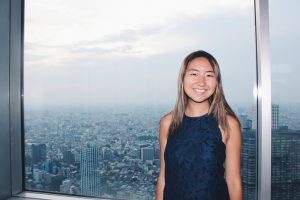
Professor Yasuake Monnai is an Assistant Professor in the Department of Applied Physics and Physico-Informatics at Keio University. He has been at Keio University for two years. Previously, he received his Bachelor’s degree in Mathematical Engineering and Information Physics and his Master’s degree and PhD in Information Science and Technology from the University of Tokyo. He has also spent a year and 3 months studying in Germany as a PhD candidate at the University of Kassel and Philipps University of Marburg. Aside from being an extremely accomplished individual, Professor Monnai is also very interesting and kind person. In fact, he was one of the people I talked to most during my welcome party on my first day at the Itoh laboratory.
Having experiences at both Keio University, the top private university in Japan, and the University of Tokyo, the highest ranked Japanese national university, Professor Monnai had much insight to offer about the differences between the public and private education systems in Japan. Because UTokyo is a national university, the educational emphasis is placed on what is best for the entire Japanese society and country as a whole. Thus, UTokyo is known for educating future politicians and businessmen, which dates back to when UTokyo was founded.
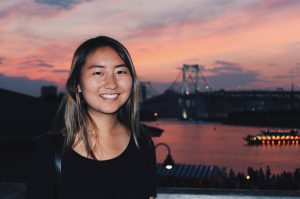
At Keio University, professors seem to be more invested in their students, and there is less distance in the professor-student relationship. For undergraduate laboratory classes at Keio, both Assistant Professors and Full Professors teach these classes and personally guide the students, while mainly Assistant Professors at UTokyo take on this role. Science and engineering students at Keio even give presentations to their professors between the end of their bachelor’s course and the beginning of their master’s, as a progress update, which is not traditionally done at UTokyo. Keio University professors seems to advise their students throughout their entire educational process, while UTokyo is generally more results-oriented. At UTokyo, the students tend to be more self-sufficient and independent because of the way education is approached. While this leads to success for the motivated students, others may fall behind in their coursework.
When Professor Monnai arrived in Germany for his research abroad experience, he spoke minimal English and felt much more comfortable with reading and writing. The experience really changed his lifestyle, and he now interacts with much more international people than he did before. He noticed that there was a very prominent distinction between the way education is approached in Japan compared to Germany. In Japanese society, the period of study is rigidly defined, with students entering university in April and finishing the year next March. PhDs are generally obtained in three years, and Japanese students must complete their PhD defense within that time period. However, PhD candidates defend their thesis when they are ready, when the timing is right. There is no predefined date in Germany. Professor Monnai thinks that Germany’s approach is a bit more reasonable and natural than Japan’s. The most likely reason for this difference is because Japan values society and the system to be the highest priority, and this rigid timing makes the recruitment process for industry jobs more streamlined.
At Keio, Professor Monnai is an Assistant Professor in the Tanaka Laboratory. He mentors five students and works with terahertz technology, which is a bit different from what the group is focused on. He currently has time for labwork and running simulations, but does have to allocate his time to applying for funding and grants. There are no facilities at Keio for THz research yet, so Professor Monnai and his students must run their samples in national laboratories. Currently, he is hoping to receive enough funding to gradually buy the equipment that is required, and grow the group into one that can function independently. Because Professor Monnai is both conducting research and personally mentoring five students, and also doing much office-related work such as applying for grants, this is most likely one of the busiest periods of his life.
In five or ten years, Professor Monnai dreams of creating technically practical products out of his research. He is interested in entrepreneurship and startups, which is a more unconventional path in Japan. He wants to have independence in his work and research in things that he is interested in. However, he also believes that education is a priority, and that the job of a professor is a very important one. Professor Monnai believes that he is normal, but claims that other people think that he is different. I am not sure who is correct, but I believe that Professor Monnai is a very interesting person to talk to, and I hope to have more conversations with him in the future.
Research Project Update
Most of the materials have arrived, but we are still waiting on the most important one – the antenna. The delay lines arrived today, and the antenna is supposed to arrive on this upcoming Friday. Last Friday, Kento and I went down to the NV center laboratory and tested the cables that were the same length to ensure that they splitter generated signals in the same phase for each of the cables. There are very small phase differences between the wires, but it should not have much of an impact overall.
I have revised my abstract draft, and Professor Itoh commented that he really liked it, so I was very happy. I submitted the abstract today and I will continue to work on my poster draft until the antenna arrives on Friday. I will most likely work on Friday, Saturday, and Sunday to try to get enough results for my presentation.
Question of the Week
Are there many females in executive positions in Japanese industry? If not, is this perceived as a problem in Japanese society and are there efforts to change this?
- Yes, this is a big issue and women in positions of leadership are rare in government, industry, or academia in Japan. Depending on the data, women account for somewhere between 3.4% – 7% of business leaders, far lower than the 30 percent target set by the government. However, Tokyo currently has a female governor, Yuriko Koike, and there are examples of women who are leaders in a number of fields.
- However, the easiest way for women to gain leadership in many nations worldwide is to start their own companies and there is not really a culture of entrepreneurship or investment funding of start-ups in Japan.
- So, women must work within the existing structures which are set up to preference long working hours which make it exceedingly hard to balance workplace and family commitments. There has been a systemic lack of investment in the infrastructure, such as pre-schools and childcare, that could help working parents bridge this challenge. This is why Japan has been called one of the “Worst Developed Countries for Working Mothers”.
- So the choice between career and family is even more stark/difficult in Japan for women than it is in other countries, such as the U.S., that also struggle with supporting working parents. For more on this see some of the articles listed on:
Week 11: Critical Incident Analysis – In the Lab
No Report Submitted
Week 12: Final Week at Research Lab
No Report Submitted
Week 13: Final Report
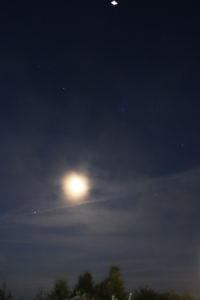
Stars: The clear night sky from hallway up the Subashiri trail of Mt. Fuji. ~ Rose Huang
After a 13-hour flight that resulted in cramps everywhere from uncomfortable sleeping positions, we finally arrived in the Houston airport. The culture shock of returning to the US was not as significant as I expected it to be, but one thing I did notice was how large everything was Houston. From the spacious hotel rooms to the generous food portions, I found this difference almost overwhelming when compared to the small sizes Japan. Other than that, I was also plagued by jetlag for most of the re-entry program, which caused me to continually fall asleep at 5 pm and wake up around 4 am.
As for the re-entry program itself, I really enjoyed the tips on how to successfully present a research poster, and the sessions on graduate school admissions and experiences. The former was very useful in practicing for the Smalley-Curl Institute (SCI) Summer Research Colloquium, especially because the seminar leader made the experience very interactive. The latter taught me a lot about the expectations for graduate school, and I learned a lot about the different programs that Rice University offers. Rice seems like an excellent place to pursue graduate studies in the engineering fields that I am potentially interested in, and I will definitely be referencing the resources from the re-entry program in the future. Furthermore, everyone from Rice who talked to us about graduate school seemed so personable and approachable, and it really made grad school applications seem less intimidating.
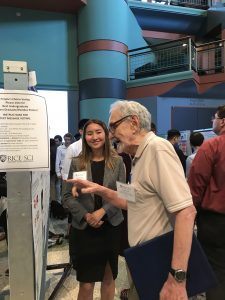
The night before the SCI colloquium, I again fell asleep around 5 pm instead of practicing my presentation, and woke up around 6 am to practice. As a consequence, I was a bit sleepy when we arrived at Rice University around 8:30 am and also a bit nervous about my last-minute preparation. Two and a half cups of coffee later, I was extremely shaky and nervous right before the start of the poster session. After talking to Savannah’s grandparents about my research, I felt a bit less nervous about the rest of the people walking around the poster session. At one point, Nobel Laureate Prof. Robert Curl came over to talk to me about nitrogen vacancy centers and my research, which was an amazing opportunity. I talk to so many people, but I really wish I had been more proactive about remembering people’s names and obtaining their contact information. In the future, I will also consider making business cards and placing my email address on my poster if anyone wants to get in touch with me about my research.
If I were to try to explain to my family members what I learned through Nakatani RIES, I would most definitely highlight my appreciation of Japanese culture and history, and my desire to learn more about my own culture. In Japan, I really enjoyed being able to travel, visit museums, immerse myself in nature, talk with Japanese people about their life experiences, and learn about the Japanese language. While I often felt reminders of how much I was an outsider in Japan, I began to understand the culture more and more throughout the internship period. However, I can’t say the same for China, where my parents grew up and immigrated from in the 1990s. I have visited China for short periods of time, stayed with my family, and noticed that China is quite dirty and that people spit everywhere. However, I have never truly experienced China as someone living there, and I am quite embarrassed by my inadequacy when it comes to the Chinese language. I really hope to learn more about the country that my parents were raised in, and the country that China is today, in order to understand myself and the history that has brought me to where I am today.
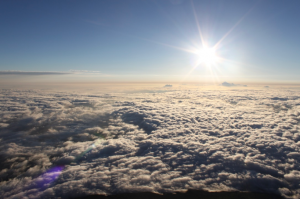
Summit: From the top of Mt. Fuji – one of the most breathtaking views that I have ever seen. ~ Rose Huang
When talking to a professor or employer about my experience with Nakatani RIES, I would really emphasize the importance of international collaboration, in both research and industry. I understand now that my views before visiting Japan were rather narrow, and centered around America. America is strong, resourceful, independent, and holds everything I need to be happy and successful in life; thus, I would not even consider working or living in another country. This is the unconscious line of thought that I had before the Nakatani RIES program. Talking with Japanese researchers and with other international researchers in Japan has opened my eyes to the power of international collaboration. For instance, my laboratory conducts research in quantum computing using nitrogen vacancy centers, and collaborated with many other labs across the world, including one in Australia. Recently, the American multinational corporation Intel has also decided to invest into developing quantum computers, and there are also laboratories and companies in Canada and other countries around the world that are working on quantum computing, sharing their technologies, and collaborating with each other. Instead of viewing other laboratories or corporations as competitors and trying to race to develop the best technology, collaboration could really improve technology and make development faster and more efficient.
To another university student, I would encourage you to be curious about learning and pursue something that you are interested in. Don’t be afraid to ask questions, no matter how silly you believe that they are. Regardless of how others perceive you, staying silent and pretending to understand something will never benefit you in the long run. Over the summer, I asked my mentor so many questions that I am surprised he didn’t get sick of me (or maybe he did), but I also learned so much more than what would have been possible if I had tried to search for the answers on my own. Most of the answers to my questions were not even on Google, but my mentor was always eager to explain and help me understand. An undying sense of curiosity and a passion for learning are things that I will definitely bring back to my classes at Columbia.
There are many changes that I would like to make to my life after attending the Nakatani RIES program. While many of these are based off of my personal experiences in Japan, one desire that I believe will be universal for mostly everyone who participates in Nakatani RIES is to travel and experience as much of the world as possible. As an engineer, it is fairly difficult to study abroad at my university. Studying abroad is not encouraged or emphasized as much as it should be, with a lack of resources and support from many departments at my university. However, I am now determined to experience at least semester abroad, and I intend to talk to the Office of Global Programs at my university as soon as I return to school. I really hope to return to Japan in the near future, but I would like to spend a semester studying in Europe, a continent that I have never before visited.
Final Question About Japan
While in Japan, I have had many questions, some that have been answered, and others that may not even have an answer. I had intended to ask this question to the professor that I talked to for the interview that I wrote about in a previous week, but we had already talked for 2 hours and I didn’t want to keep him any longer. I have noticed, especially in my laboratory, that there are not many young adult females in engineering and science fields. When I tell others that I am studying engineering, they are often surprised, perhaps due to my gender. How big is the gender inequality in STEM fields in Japan and are there any initiatives that are being implemented to encourage more females to study STEM?
- You may want to read through some of the weekly reports from the female participants in the 2017 Nakatani RIES Fellowship for Japanese Students. They discuss various aspects of being a women in STEM fields in terms of both their experience in Japan and what they have learned from doing research in the U.S.
- See also the section on Women in Science & Engineering in Japan on our Doing Research page.
Follow-on Project
I would like to talk to the Office for Global Studies at Columbia University about any international internship/research fairs, and try to open a table for Nakatani RIES if there is a fair. I will also ask if there are any engineering research fairs. I would like to put up flyers around the dormitories and around public spaces to advertise the program, because I found out through a flyer. Furthermore, I intend to post a blurb about applying for the Nakatani RIES Program on the Class of 2020 Facebook page for my university, which is heavily used by many students.
In addition to promoting Nakatani RIES to students at my university, I really want to share this experience with students from my high school, NCSSM. I attended a public 2-year STEM boarding school, and the students in my class and the class below mine are in the right year of college to apply for the program. Furthermore, the majority of these students are extremely passionate about STEM and research, and I think they would really love to learn more about the opportunity. While it is not possible for me to give a talk at this high school to the current students, I will post information on the NCSSM Classes of 2016 and 2017 Facebook group. Already, I have had former classmates ask about the Nakatani Program, and I think sharing information about the the program would garner a lot of attention and interest.
Tips for Future Participants
Pre Departure Tips
- Shopping in Japan can be a bit overwhelming, especially if you do not speak Japanese very well, but there are many sales about halfway through the summer.
- If you intend on buying any clothing, I would recommend packing less of your own clothing and shoes. You really only need 4-5 pairs of shoes, max, but I think I left Japan with around double that amount.
- Also, if possible, don’t bring more than one suitcase, and don’t stress out too much about what omiyage to bring your lab.
Orientation Program Tips
- Eat as much udon at the Sanuki Club as possible (it’s so amazing).
- Also, try not to fall asleep during language class or the other seminars throughout the day.
- Try to do things at night or during the weekend that you may not be able to do later on, especially if you are not researching in Tokyo.
- Don’t be afraid to venture out on your own, but put your own safety first and make sure you know where you are going.
Mid-Program Meeting Tips
- Talk to the Japanese fellows as much as possible.
- And don’t worry too much about the research presentation or not having the results that you want.
Working With your Research Lab:
- Try really hard to talk to them, not only about research, and in Japanese if you can.
- Get dinner with your lab mates, go out for drinks (even if you drink a non-alcoholic drink), and get to know them as people. I wish I had taken more initiative at the beginning to get to know people. For the first two weeks, I thought I would not make any friends in my lab, until my mentor invited me to ramen one night.
Living in your Research Host City
- Go to Daiso or other hyaku yen shops (100 yen/dollar stores) to buy plates, silverware, clothing hangers, anything you need (instead of going to Muji like me…). There is a Daiso at Hiyoshi station on the 3rd floor of Tokyu Department Store if you are working at Keio.
- At my dormitory, it was very easy to cook because pots and pans were provided to us.
- Also, Tokyo is very very close, especially if you take the Toyoko commuter express line (15 minutes away from Shibuya), and try to explore as much as possible. Go out for dinner on weekdays, meet up with other students in the Tokyo area, and get to know people in your dormitory and laboratory.
Language Study Tips
- If you are really dedicated to learning Japanese, you can perhaps look for someone in your laboratory who is willing to practice with you, or find someone in your dormitory if anyone speaks Japanese or is interested in learning. It would also be helpful to take a Japanese class at your home university before you leave, if it’s possible.
Other Tips/Suggestions for Future Participants
- What Gifts to Bring: Chocolate, postcards from your hometown, non-perishable food that you enjoy
- What to Eat: ramen, Udon, okonomiyaki, yakitori, soba, gyoza, matcha parfaits
- What to Buy in Japan: Souvenirs for your friends, family, and lab mates (postcards and food are cheap), charcoal soap (this stuff is amazing for your skin), as much Japanese food as you can fit in your stomach
- What to Do in Japan: Make the most out of your time but also enjoy some time to relax and reflect on your summer, don’t feel too bad if you miss something because you will have time to come back to Japan later in life
- Places to Visit in Japan: Visit UNESCO world heritage sites if that interests you. Places that I visited include:
- Tokyo (most of the more well-known wards)
- Yokohama (Minato Mirai area is beautiful)
- Kamakura (there is a giant Buddha statue and nice beaches)
- Osaka (Dotonbori and Osaka Castle)
- Kyoto (for the Mid-Program Meeting)
- Himeji (UNESCO site – Himeji Castle)
- Kurashiki (the historical district is lovely)
- Naoshima (if you love modern art)
- Hiroshima (WWII memorials and museums)
- … and Mt. Fuji!!
